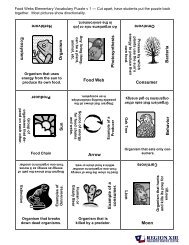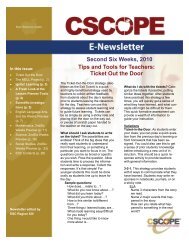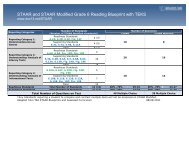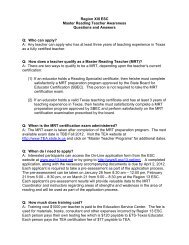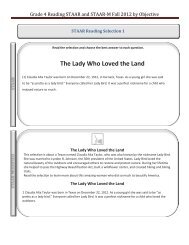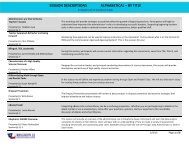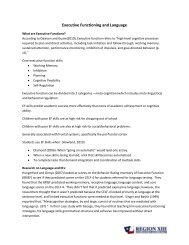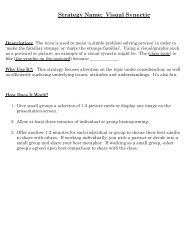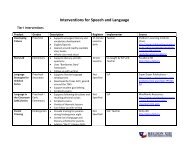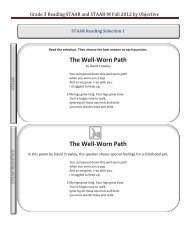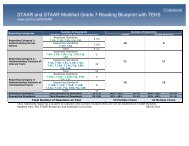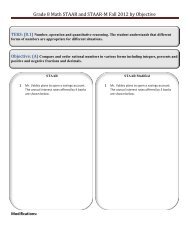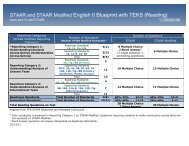Companion II: Intellectual Disability/Multiple Disabilities
Companion II: Intellectual Disability/Multiple Disabilities
Companion II: Intellectual Disability/Multiple Disabilities
Create successful ePaper yourself
Turn your PDF publications into a flip-book with our unique Google optimized e-Paper software.
Communication DisorderA communication disorder is impairment in the ability to receive, send, process, and comprehendconcepts or verbal, nonverbal, and graphic symbol systems. A communication disorder may beevident in the processes of hearing, language, and/or speech. A communication disorder mayrange in severity from mild to profound. It may be developmental or acquired. Individuals maydemonstrate one or any combination of communication disorders. A communication disordermay result in a primary disability or it may be secondary to other disabilities (ASHA, 1993). Acommunication disorder can be diagnosed in an individual with intellectual disabilities if thespecific deficit is out of proportion to the severity of the intellectual disability (DSM-IV-TR, p.47).Language DisorderA language disorder is impaired comprehension and/or use of spoken, written, and/or othersymbol systems. The disorder may involve (1) the form of language including phonology,morphology, and syntax, (2) the content of language/semantics, and/or (3) the function oflanguage in communication/pragmatics, in any combination (ASHA, 1993).American Psychiatric Association (2000). Diagnostic and statistical manual of mental disorders(4 th ed., text revision). Washington DC: Author.American Speech-Language-Hearing Association. (1993). Definitions of CommunicationDisorders and Variations [Relevant Paper]. Available from www.asha.org/policy.Code of Federal Regulations, Title 34, Chapter 300.NICHCY <strong>Disability</strong> Fact Sheet #8: <strong>Intellectual</strong> <strong>Disabilities</strong>. January 2011. Retrieved fromhttp://nichcy.org/wp-content/uploads/docs/fs8.pdf.6
Communication Bill of RightsAll people with a disability of any extent or severity have a basic right to affect, throughcommunication, the conditions of their existence. All people have the following specific rights intheir daily interactions (National Joint Committee for the Communication Needs of Persons withSevere <strong>Disabilities</strong>, 1992).Each person has the right torequest desired objects, actions, events, and people;refuse undesired objects, actions, or events;express personal preferences and feelings ;be offered choices and alternatives;reject offered choices;request and receive another person's attention and interaction;ask for and receive information about changes in routine and environment;receive intervention to improve communication skills;receive a response to any communication, whether or not the responder can fulfill therequest;have access to AAC (augmentative and alternative communication) and other AT(assistive technology) services and devices at all times;have AAC and other AT devices that function properly at all times;be in environments that promote one's communication as a full partner with other people,including peers;be spoken to with respect and courtesy;be spoken to directly and not be spoken for or talked about in the third person whilepresent;have clear, meaningful, and culturally and linguistically appropriate communications.From the National Joint Committee for the Communicative Needs of Persons with Severe<strong>Disabilities</strong>. (1992). Guidelines for meeting the communication needs of persons withsevere disabilities. Asha, 34(Suppl. 7), 2–3.7
Communication Model(Rudebusch & Wiechmann, 2006)Communication involves using hearing, language, and speech to receive, send, process, andcomprehend concepts or verbal, nonverbal, and graphic symbol systems. The speech bases ofcommunication include articulation of speech sounds, fluency, vocal quality, pitch, loudness, andresonance (Figure 1). The modalities of language (listening, speaking, reading, and writing) areused to exchange ideas, concepts, and information. Language systems consist of:Language formo Phonology – the sound system and rules that govern the sound combinationso Morphology – the system that governs the structure of words and construction ofword formso Syntax – the system governing the order and combination of words to formsentences and the relationships among the elements within a sentenceLanguage contento Semantics – the system that governs the meanings of words and sentencesLanguage function/useo Pragmatics – the system that combines language components in narrative,functional, and socially appropriate communicationo Metalinguistics – the logical understanding of the rules used to govern languageand to analyze language as a process or a systemLanguage and communication are used for three purposes: for social interaction, to expressintentionality, and to regulate the behavior of self and others (Figure 1). The SLP has animportant role in evaluating the communication skills that transcend symbol use expressedthrough speech and language.Rudebusch, J. & Wiechmann, J. (2006). The Communication Model. Houston, TX: Authors.The Communication Model was developed from the following resources:Greenspan, S.I. & Wieder, S. (2000). A developmental approach to difficulties in relating andcommunicating in autism spectrum disorders and related syndromes. In S.F. Warren & J. Riechle(Series Eds.) & A.M. Wetherby & B. M. Prizant (Vol. Eds.), Communication and languageintervention series: Vol. 9, Autism spectrum disorders: A developmental transactionalperspective (pp. 279-306). Baltimore: Paul H. Brookes Publishing Co.Mundy, P. & Stella, J. (2000). Joint attention, social orienting, and communication in autism. InS.F. Warren & J. Riechle (Series Eds.) & A.M. Wetherby & B. M. Prizant (Vol. Eds.),Communication and language intervention series: Vol. 9, Autism spectrum disorders: Adevelopmental transactional perspective (pp. 55-77). Baltimore: Paul H. Brookes Publishing Co.8
National Research Council, Division of Behavioral and Social Sciences and Education,Committee on Educational Interventions for Children with Autism (NRC). (2001). Educatingchildren with autism. Washington, DC: National Academies Press.Prizant, B.M., Schuler, A.L., Wetherby, A.M., & Rydell, P.J. (1997). Enhancing language andcommunication: Language approaches. In D. Cohen & F.R. volkmar (Eds.), Handbook of autismand pervasive developmental disorders (2 nd ed., pp. 572-605). New York: Wiley.Prizant, B.M., Wetherby, A.M. Rubin, E., Laurent, A.C. & Rydell, P.J. (2006). The SCERTSmodel: A comprehensive educational approach for children with autism spectrum disorders,(Vol. 1, Assessment). Baltimore, MD: Paul H. Brookes Publishing Co.Rydell, P.J. & Prizant, B. (1995). Assessment and intervention strategies for children who useecholalia. In K. Quill (Ed.), Teaching children with autism: Strategies to enhancecommunication and socialization (pp. 105 – 129). Albany, NY: Delmar.Wetherby, A.M. & Prizant, B.M. (2002). Communication and Symbolic Behavior Scales:Developmental Profile (CSBS DP) (1 st normed ed.). Baltimore: Paul H. Brookes Publishing Co.9
Communication ModelFLUENCY ARTICULATION VOICEInteractionShared EmotionShared Smile or LaughExpression of Emotionfor CommunicationJoint AttentionGaze ShiftsGaze FollowDirects Another’sAttentionReciprocal InteractionCommentsRequests InformationLanguage ModalitiesSpeakingListeningReadingWritingLANGUAGELanguage SystemSyntaxSemanticsPragmaticsMetalinguisticsPhonologyIntentionalityBehavior RegulationRequest/Protest/RejectObject or ActionSocial InteractionInitiationResponseMaintenanceTerminationRepairRequest ComfortSocial GamesTurn-TakingGreetingsShow OffCallsGesturesObjectsWordsSymbol UsePictures/GraphicsSign LanguageSpeech-SoundsPrepared by Rudebusch & Wiechmann,2006MutualExpresses Range of EmotionResponds to AssistanceRequests Assistance to RegulateRecovers from Extreme DysregulationRegulationSelfUses Communication/Language to Self-RegulateRegulates Emotion during New & Changing SituationsRecovers from Extreme Dysregulation by Self
Service Delivery and Systems of SupportsSpeech-language pathologists have a critical role in ensuring that the communication needs ofpersons with intellectual disabilities and multiple disabilities are met across the lifespan (ASHA,2005). Specific to school settings, SLPs provide direct and indirect services for students withcommunication disorders when these services and supports are needed to assist students inmaking progress in the general curriculum or benefiting from the specially-designed instructionspecified in the Individualized Education Program (IEP). SLPs address communication skills thatpromote the following (ASHA, 2005):Literacy and functional academic skills;Access to the general curriculum, extracurricular activities, and experiences with peers ofthe same age without disabilities;Participation in general education assessments and evaluations with appropriateaccommodations and alternative assessments as needed; andSuccessful future transitions to post-high school environments (educational, residential,recreational, vocational).A service delivery framework and systems of supports for students with intellectual disabilitiesand multiple disabilities are provided that allow for communication interventions that focus onfunctional communication outcomes and intervention environments that provide numerous andsustained interaction opportunities for communication involving:<strong>Multiple</strong> communication functions and content;<strong>Multiple</strong> communication partners; and<strong>Multiple</strong> communication contexts.Purpose of SLP Services for Students with <strong>Intellectual</strong> <strong>Disabilities</strong>/<strong>Multiple</strong> <strong>Disabilities</strong>The Individuals with <strong>Disabilities</strong> Education Act (IDEA 2004) describes speech-language therapyas a related service but gives states discretion to consider speech-language therapy as aninstructional service. Specifically, IDEA defines related services as transportation and suchdevelopmental, corrective, and other supportive services necessary for a child with a disability tobenefit from special education. “In Texas, speech-language therapy is considered an instructionalservice. This means it can be a stand-alone service as well as a supportive service” (TexasEducation Agency, 2009). When speech impairment is the only disability, speech-languagetherapy is considered an instructional service. Speech-language therapy services are considered arelated or supportive service when there are one or more other disabilities.When speech impairment is the only disability, the purpose of speech-language therapy is toprovide the specially-designed instruction (outlined in the IEP) that the student needs in order tomake progress in the general curriculum.
When speech impairment is present with intellectual disability or multiple disabilities, thepurpose of speech-language therapy is a supportive service to help the student benefit from thespecially designed instruction provided in special education. Speech, language, andcommunication skills are embedded in state standards in the form of the Texas EssentialKnowledge and Skills (TEKS) and core curriculum for each grade level and course. Speech,language, and communication skills are typically most closely aligned with English LanguageArts and Reading TEKS and should be addressed on a daily basis by the classroom teacher. TheSLP should consider the assistance and support the teacher might need in order to address thespeech, language, and communication skills that are part of the curriculum. As a supportiveservice, speech-language therapy is provided to enhance the student’s academic and functionalcommunication abilities for independence and self-advocacy and to make progress through thecurriculum (ASHA, 2005).Service Delivery FrameworkThe service delivery models used by SLPs for students with intellectual disability, multipledisabilities, and communication disorders are individualized on the basis of each student’scommunication needs and the supportive services needed to help them benefit from their specialeducation program. The dimensions of service delivery include the type of service (direct orindirect), where the services are provided, by whom, and on what schedule. The student’sIndividualized Educational Program (IEP) must specify the frequency, location, and duration ofspecial education and related support services. In addition, the IEP should delineate the directand/or indirect SLP services needed to support the student in his/her special education program.Service delivery options for students with intellectual disability or multiple disabilities typicallyinclude three models: pull-out, classroom-based, and collaborative consultation (ASHA, 2005).The Admission, Review, Dismissal (ARD) Committee determines the service delivery model orcombination of service delivery models most likely to result in progress for the student, keepingin mind the overarching purpose of improving functional communication and supporting thestudent in making progress in the specially designed instruction provided through specialeducation.Pull-Out Model: The SLP typically works with a small group outside of the classroom,often in a speech therapy room. The rationale for this model is that it may be moreeffective and efficient than other models for teaching specific skills that benefit fromrepeated trials (e.g. articulation training), for teaching new behaviors (e.g. initial use of anAAC device), for structuring conversational exchanges, for minimizing auditory andvisual distractions, and for privacy. Despite these considerations, exclusive use of thepull-out model for students with intellectual disability/multiple disabilities is rarelyappropriate because of the compelling need to provide services and opportunities to usecommunication skills in naturally occurring contexts and environments.Classroom-Based Model: The SLP provides direct and indirect services within thecontext of the classroom to support the communication skills needed to benefit frominstruction. The classroom-based model typically consists of co-teaching approaches suchas team-teaching, station-teaching, or parallel-teaching provided by the classroom teacher
and SLP. It is best practice for the classroom teacher and paraprofessionals to remain inthe classroom with the SLP in order to maximize opportunities for them to learncommunication strategies.Collaborative Consultation Model: The SLP provides indirect services to supportcommunication skills in the classroom and across multiple contexts and environments atschool, home, and in the community. Collaborative/consultation services are provideddirectly to the classroom teacher/s or other service providers on behalf of the student inorder for the IEP to be implemented. These services may include observations of thestudent, peers, and instructors in the learning environment, discussions with teachers,paraprofessionals, and other service providers regarding methodology and strategies, orwritten recommendations provided to the classroom teacher or other service provider.American Speech-Language-Hearing Association. (2005). Principles for Speech-LanguagePathologists Serving Persons With Mental Retardation/Developmental <strong>Disabilities</strong>. Available athttp://www.asha.org/members.deskref-journals/desref/default.Texas Education Agency. (2009). Related Services for Students with <strong>Disabilities</strong> – Questionsand Answers. Available at http://ritter.tea.state.tx.us/special.ed/resources/relservqna.pdf.
Service Delivery & Support Services for <strong>Intellectual</strong> <strong>Disabilities</strong>/<strong>Multiple</strong> <strong>Disabilities</strong>ModelLocationPull-Out Natural Learning Environment/Classroom-Based Natural LearningEnvironment/Combination Direct andIndirectSmall group;typically forteaching newskills, discretetrialSpeech therapyroomTeam-Teaching Parallel-Teaching Station-TeachingTeacher and Students are Teacher and SLP/ASLP/A share divided into two divide class into 3responsibility groups. SLP/A groups. Teacherof leading and teacher lead and SLP/A eachwhole group samelead a group. andinstruction instruction/lesson one group workswith different during the same independently.but equally timeframe. Students rotate toactive roles.all stations.Classroom(general ed orspecial ed)Provider SLP/A SLP/A andclassroomteacher and/orserviceprovidersSchedule ofServicesSHARSClassroom(general ed orspecial ed)SLP/A andclassroomteacher and/orservice providersClassroom (generaled or special ed)SLP/A andclassroom teacherand/or serviceprovidersBased on the student’scommunication needs, acombination of direct andindirect services areprovided.Classroom (general ed orspecial ed), speech therapyroom, community-basedSLP/A and classroomteacher and/or serviceprovidersInstructional Instructional Instructional Instructional Instructional andsupplementaryaids/servicesBillable Billable Billable Billable Direct services are billable.Indirect services are notbillable.Indirect ServiceOnlyIndirect servicesare provided toadults on behalfof the student’sIEP. The studentmay or may notbe present.<strong>Multiple</strong> schoolenvironmentsSLP/A workswith classroomteachers, serviceproviders,and/or parentson behalf of thestudent’s IEPSupplementaryaids/servicesand/oraccommodationsNot billable
Multidisciplinary Team Evaluationsfor <strong>Intellectual</strong> <strong>Disability</strong> and Communication DisorderIDEA 2004 requires the use of a multidisciplinary team (MDT) to determine eligibility anddevelop the IEP for students with disabilities. Required team members include “an individualwho can interpret the instructional implications of evaluation results…” and/or “other individualswho have knowledge or special expertise regarding the child, including related servicespersonnel as appropriate…” [CFR §300.321; 19 TAC §89.1050 (c)(1)]. For students with asuspected disability in the areas of speech, language, or communication, this requirement is metwith the inclusion of the SLP on the multidisciplinary evaluation team.In response to these guidelines, TSHA has provided additional guidelines for the determinationof a communication disorder. Included in these guidelines is the use of multiple sources of data.As the specialist in the area of communication disorders, the SLP becomes an integral part of theMDT for:defining the assessment question/s;collecting data from multiple sources;assessing the communication competence (use of communication, listening, expressivecommunication, non-verbal communication, and use of assistive technology, asappropriate);determining the impact communication skills in relation to the student’s intellectualabilities;identifying the presence of a communication disorder;evaluating the impact of the communication disorder on academic achievement andfunctional performance; anddeveloping an educational plan to address the student’s needs.
<strong>II</strong>. Planning the Evaluation
Assessment Questions1. The multidisciplinary team examines the referral information to determine the areas ofconcern.2. The team develops assessment questions that, when answered, provide sufficientinformation about the student’s learning profile to guide instruction, intervention, or IEPdecisions.3. The assessment questions determine which formal and informal tests and procedures areselected for administration. When assessing for possible intellectual disabilities, themultidisciplinary team poses questions about the deficit areas or areas where the studentseems to be struggling to meet grade-level expectations and practical and social adaptiveskills expected for that age-level.Example:a. Teacher concerns: Student has difficulty across academic areas and adaptivebehavior skills (such as communication, self help skills, etc.).b. Assessment question: Does the student exhibit an intellectual disability and/or acommunication disorder that contributes to low academic performance?c. The team may choose to include a formal measure of language, a classroomobservation of communication environments, an informal measure of functionalcommunication skills, a formal measure of intelligence, and a formal measure ofadaptive behavior.4. For three-year re-evaluations, the multidisciplinary team uses the present levels ofacademic achievement and functional performance as well as data about progress on IEPgoals and information from the student’s curriculum (general education and/or specialeducation) to develop the assessment questions.
Individual Evaluation Plan1. IDEA 2004 requires that the child is assessed in all areas related to the suspecteddisability, including, if appropriate [CFR §300.304 (c) (4)]:a. Healthb. Visionc. Hearingd. Social and emotional statuse. General intelligencef. Academic performanceg. Communicative statush. Motor abilitiesi. Adaptive behavior2. The Individual Evaluation Plan allows the multidisciplinary team (MDT) to identify theareas that have been sufficiently addressed with data in the referral information and theareas that need further in-depth assessment. The Individual Evaluation Planning form isthen completed. MDT members’ responsibilities are defined, and a targeted completiondate is given. The MDT should allow time for analysis and interpretation of assessmentdata along with collaboration to determine if the assessment data is comprehensiveenough to diagnose and make educational recommendations for the ARD committee toconsider.3. The SLP’s role in planning the evaluation is to review the available information anddiscuss the tests and subtests needed to address communication skills that may contributeto the student’s struggle to meet grade-level expectations or make progress in theircurriculum (general education or special education). Consideration should also be givento planning assessment activities that provide comprehensive information about thestudent’s communication profile and adaptive functioning.4. When evaluating a student with possible intellectual disabilities or multiple disabilities,the SLP should focus more on informal measures than formal measures. Due to thecognitive limitations of the student, standardized scores typically do not yield usefulinformation for describing or making recommendations for the student’s communicationskills. Formal measures may be used for initial diagnosis of intellectual disability, butgenerally do not yield information that is useful for identifying a speech impairment inthe area of functional communication skills.5. It is beneficial for the SLP to provide the MDT with examples of the student’s currentcommunication modes (e.g. nonverbal, Picture Exchange Communication System,pointing to objects from a field of 5). This will help determine if standardized tests arevalid measures for the student or if the test(s) need to or can be modified.
Detailed information regarding various formal and informal assessments is included inthe TSHA Language Eligibility Manual, 2011. Additional data collection tools areavailable in section VI. Forms of this manual.
Individual Evaluation Planning FormStudent: Grade/Age: School: Primary Language:Multidisciplinary Team Members:Date Referral Received:Current Mode of Communication:Date of Planning Session:Referral Information/Concern:Learning Profile:Teacher data or RTI dataAssessment Question/s:SociologicalArea Address Assess MDT MemberResponsibleTests/ProceduresTargetCompletionPhysical/Motor/MedicalGeneral IntelligenceAdaptive Behavior
Emotional/BehavioralAssistiveTechnologySpeech-LanguageCommunicationArticulationVoiceFluencyLanguageSyntaxPhonologySemanticsPragmaticsMetalinguisticsTests and Assessment Procedures to be Used:
<strong>II</strong>I. Conducting the Evaluation
A. Language with <strong>Intellectual</strong> <strong>Disabilities</strong>/<strong>Multiple</strong> <strong>Disabilities</strong> EligibilityFlow ChartConcerns brought forward for evaluation thatindicate need for multi-disciplinary teamevaluation to address ID/MD.Individual Evaluation Plan developed based on student data.Evaluation data gathered: teacher data, parent data, observations of communicationskills, language/communication sample, standardized tests, checklists.Determine if data is adequate for documentation of disability conditions.Data indicates acommunication disorderis present withcommunication skillsthat are out ofproportion with overallfunctioning. Evaluationis sufficient.Conflicting Data orNot All Areas Adequately Assessed:Conduct additional testing and informal assessments.If appropriate, integrate standardized testresults into a cross-battery analysis format.Data indicates acommunication disorderis not present.Communication skillsare proportional tooverall functioning or arelative strength.Evaluation is sufficient.Additional datasupports presence of alanguage orcommunicationdisorder.Additional data does notsupport presence of alanguage orcommunicationdisorder.Data supportsadverse effect onacademicachievement orfunctionalperformance.SI eligibility criteria are met.No adverse effect resulting from communication disorder.No need for direct SLP servicesARD meeting to determineeligibility for specialeducation, determineprogram, and determine ifspeech-language therapyare needed.ARD meeting todetermine not SIeligibleand todefine indirect/consultation role ofSLP, if any.
Step-by-Step for SI-Eligibility1. A non-identified student, teacher, or parent brings learning concerns to the Student SupportTeam (SST). If language is indicated as a concern, the Speech-Language Pathologist (SLP)participates in a review of existing data. Parent(s), teacher(s), and other school staff provideinformation about the student to bring to the Student Support Team (SST) meeting,including:a. Vision and hearing screening;b. Data about student performance, such as grades, attendance, response to extra supportand intervention, state and district assessment results, and/or reading level; andc. Parent Language Survey and Parent/Teacher Communication Survey.2. SST members discuss concerns about the student and:a. suggest recommendations for further classroom support or focused interventionand/orb. refer for special education evaluation if the student has an obvious disability.In the case of (2a), the SST reconvenes after the recommended support and interventionhave been provided and determines from data collected if referral for a full and individualevaluation is recommended or if interventions have been successful.In the case of (2b) or if classroom support and interventions have not been successful, theSST makes a referral to special education for a full and individual evaluation. If anintellectual disability is suspected, the SST should be careful to not delay a referral tospecial education for evaluation.3. In the case of a student already identified as having a disability but for whom an additionaldisability is suspected, the SST or the Admission, Review, Dismissal (ARD) Committeereviews existing data, including prior evaluations. If the student has been previouslyidentified as having a Speech Impairment (SI), and/or language is indicated as a concern, theSLP participates in the multidisciplinary team review of existing data.4. If a referral is initiated or an additional evaluation is planned, follow district procedures forproviding all Notice, Consent, and Procedural Safeguards to parents.5. The MDT reviews the referral to plan the evaluation. The Individual Evaluation Planningform is completed.6. SLP, Educational Diagnostician, Licensed Specialist in School Psychology (LSSP), and otherMDT members complete standardized testing and formal and informal assessmentprocedures, including collecting teacher data, parent data, observation data,language/communication sample, and checklists.
7. When a communication disorder is present, the SLP compiles documentation to addresswhether there is an adverse effect on educational performance (i.e. academic achievementand functional performance) resulting from the communication disorder.8. The Educational Diagnostician and/or LSSP, in cooperation with the SLP, write an integratedFull and Individual Evaluation (FIE) report that addresses all areas of disability with links toinstructional considerations that address area(s) of disability.9. If there is evidence for SI eligibility with the communication disorder, the SLP shouldprepare communication remediation recommendations to be presented to the ARDCommittee.10. The ARD meeting is scheduled to review the FIE to determine eligibility for specialeducation and related/supportive services.11. If SI eligibility and direct services are warranted, the SLP drafts goals and objectives forARD approval.12. If SI eligibility is not determined with direct services, the ARD committee, with SLP input,defines indirect/consultation role of SLP, if any.13. If SI eligibility is not determined, the SLP may make recommendations for instructionalaccommodations or modifications for the classroom teacher based on the evaluation data.The communication-related instructional recommendations should be incorporated in theARD/IEP.
Formal Data CollectionFormal measures may be administered to students with possible intellectual disabilities ormultiple disabilities. Refer to the TSHA Language Eligibility Guidelines Manual 2011, fordetailed descriptions.When evaluating students with possible intellectual disabilities or multiple disabilities,standardized scores allow the SLP to quantify the student’s communication skills and assist withdetermination about whether communication skills are relative strengths or weaknesses withinthe student’s overall developmental and learning profile. However, the SLP should conductinformal measures in order to more fully describe the student’s present levels of functionalperformance in the area of communication.
Informal Data CollectionInformal data collection for students with possible intellectual disabilities or multiple disabilitiesyields a qualitative description of the student’s communication skills. Informal measures allowfor an analysis of the student’s communication strengths and weaknesses across communicationenvironments and with a variety of communication partners.Refer to the TSHA Language Eligibility Guidelines Manual 2011, to review the availableinformal assessment tools. In particular, the Conversational Checklist and Communicative IntentEvaluation (Wetherby, Cain, Yonclas, & Walker, 1988) may be applicable for this type ofevaluation.Additional resources for informal measures of communication skills:Parent/Teacher Communication Inventory (included in Forms section of this manual)Functional Communication Profile: RevisedL. I. Kleiman, available from LinguiSystemsFunctional Language Assessment and Intervention SourcebookL. J. Mattes, available from Academic Communication AssociatesSchool Function AssessmentW. Coster, available from Pearson Education, Inc.
IV. Analyzing and Interpreting the Data
Evaluation Summary FormCommunication Profile: <strong>Intellectual</strong> <strong>Disabilities</strong>/Severe <strong>Multiple</strong> <strong>Disabilities</strong>Student: ___________________________________SLP: _____________________Date of Birth: ___________ CA: _______ Campus: ____________ Date Completed: ______Assessment Questions: __________________________________________________________Evaluation Tool Results DataSupportsConcernYesNoTeacher Language/Communication SurveyParent Language/Communication SurveyInformal AchievementDataCriterion-ReferencedMeasuresCurriculum-BasedMeasuresFunctionalIndependence DataWork SamplesClassroom TestsGradesIntervention DataFormal Achievement DataTests used:Area of Academic Concern:Language ComprehensionOral ExpressionSemanticsSyntaxMetalinguisticsPragmaticsPhonologyCommunication skills are/are not proportional to level ofachievement.
MDT AssessmentFunctional SkillsSelf-Care:Results/CommentsYesNoCognitive AbilitiesTests Used/Results:Motor Skills:Adaptive FunctioningTests Used/Results:Daily Living Skills:Social Interaction:Nonverbal Behaviorsto RegulateInteractionsTurn-TakingJoint AttentionShared EmotionUse of Communicationto RegulateInteractionsInitiate/SustainConversationCommunication:IntentionalityRequest, Protest, RejectInteractionInitiate, Respond,Maintain, Terminate,Repair, Request,GreetingsLanguageSocio-Dramatic/Pretend PlaySymbol Use
Language Samples:Conversation/AdultsConversation/PeersNarrativeCommunication Sample:VerbalMLU-M ______No. of Words: Receptive ___ Expressive ___Overall Intelligibility ________Comm. Modalities: Verbal with __ gesture, __ sign, __ AACNonverbalCommunication modality: _________ (i.e. sign, gesture,AAC)___ initiate ___ social interaction___ clarify ___ requestIf all of the measures reported above support the referral concern, a pattern of intellectual disabilities ormultiple severe disabilities has been identified by the MDT, and communication skills are out ofproportion with the severity of the intellectual disability, then consideration of a communication disordersecondary to intellectual disabilities is indicated. If there is any disagreement within the data listed above,continue the assessment by administering additional informal procedures to collect sufficient data.Additional InformalMeasures:
Recommendations to the ARD CommitteeYesNoStage I:Presence of a CommunicationDisorderEvidence:Communication skills aredisproportionate to the severityof intellectual disabilities.Stage <strong>II</strong>:Adverse Effect on EducationalPerformanceAbility to benefit from specialeducation program iscompromised because ofcommunication skills.Evidence: (enter rating from Adverse EffectRubric)Academic Achievement: _____Functional Performance: _____If yes to Stage I and <strong>II</strong>, then SIeligibility criteria is met.If SI, then address Stage <strong>II</strong>I:Is specially designed instructionby an SLP needed to help thestudent benefit from the specialeducation program?Evidence:
<strong>Disability</strong> Condition/s ConsiderationsEligibility Recommendations for <strong>Intellectual</strong> <strong>Disabilities</strong>The diagnostician/licensed specialist in school psychology (LSSP) and the MDT membersconduct formal and informal assessments and provide recommendations to the ARD committeeregarding a possible intellectual disability. An intellectual disability is established when theanswer is “yes” to the following two questions:1. Does the student exhibit a significantly sub-average IQ (below 70) plus or minusthe standard error of measurement?2. Does the student exhibit significant limitations in adaptive functioning in at leasttwo areas (i.e. communication, self-care, home living, social/interpersonal skills,use of community resources, self-direction, functional academic skills, work,leisure, health, and safety)?The presence of a communication disorder may or may not be linked to the presence of anintellectual disability. A communication disorder can be diagnosed in an individual withintellectual disabilities if the specific deficit is out of proportion to the severity of the intellectualdisability (DSM-IV-TR, p. 47).Eligibility Recommendations for <strong>Multiple</strong> <strong>Disabilities</strong>The diagnostician/licensed specialist in school psychology and MDT members conduct formaland informal assessments and provide recommendations to the ARD committee regarding thepresence of multiple disabilities. The term multiple disabilities is used to describe the disabilitycondition when two or more severe disabilities are present, resulting in significant educationalneeds that cannot be accommodated in special education programs solely for one of theimpairments. This disability category is reserved for students with multiple severe conditionsthat often lead to limited functioning and dependence on others. Deaf-Blind is not included in themultiple disabilities category. A speech impairment paired with another disability also does notmeet the criteria for multiple disabilities.The SLP ensures that the student’s communication functioning and needs are addressed in theevaluation report and makes recommendations to the ARD committee regarding SI eligibilityand services.Eligibility Recommendations for Speech ImpairmentRefer to the evaluation summary Communication Profile for <strong>Intellectual</strong> <strong>Disabilities</strong>/<strong>Multiple</strong><strong>Disabilities</strong> for a summary of evaluation data to support the eligibility recommendation forspeech impairment. When the answers to stage I and stage <strong>II</strong> questions are “yes,” the MDTrecommends consideration of speech impairment as an eligibility condition.
Stage I: Is there evidence of a communication disorder that is out of proportion with thestudent’s overall functioning?Stage <strong>II</strong>: If so, is there evidence of an adverse effect on educational performance(academic achievement or functional performance) resulting from the communicationdisorder?If speech impairment eligibility criteria are met, then a third question should be answered.Stage <strong>II</strong>I: Are specially designed services by a speech-language pathologist or SLPassistantneeded in order for the student to benefit from his/her special educationprogramming?The condition of speech impairment is not recommended when student data leads the SLP toanswer “no” to Stage I or <strong>II</strong>. If the answer to Stage I is “no,” the Stage <strong>II</strong> question isautomatically answered “no.”A Word about Cognitive ReferencingCognitive referencing refers to the comparison of scores on norm-referenced tests of languageabilities to scores on norm-referenced tests of cognitive abilities or intellectual functioning(ASHA, 2000). Cognitive referencing should not be used for the identification of speech orlanguage impairment. In the case of assessing for a communication disorder with an intellectualdisability, language skills are compared to the student’s intellectual functioning, but emphasis isplaced on functional communication, social problem solving, and adaptive skills. The SLPconsiders the intellectual functioning of the student with a reasonable expectation that languageskills (scores or functional performance) may be within the student’s range of significantlybelow-average functioning. Therefore, references to a student’s language skills beingcommensurate or not commensurate with overall functioning, including adaptive problemsolvingand intellectual functioning, is viewed as part of the student’s cognitive profile. Use of asimple discrepancy calculation should not be used for determination of a language disorder.Using a Cross-Battery Analysis with <strong>Intellectual</strong> <strong>Disabilities</strong>The SLP may complete a cross-battery analysis (XBA) in order to look at the student’s cognitiveabilities in Gc (Crystallized Knowledge) as related to overall cognitive performance. Somethoughts to consider when completing cross-battery analysis for a student with intellectualdisabilities include:It is not uncommon for diagnosticians/LSSPs to administer different intellectual andachievement tests than what is typical for an XBA learning disability evaluation.Therefore, the multidisciplinary team (MDT) may not have measured all of the broad andnarrow cognitive abilities in the Cattell-Horn-Carroll (CHC) theory of cognitive abilities.When completing cross-battery analysis for a student with intellectual disabilities, theSLP focuses on the language areas of cognition as part of the student’s cognitive profile.One would expect the scores to be below average; however, the language area may be a
elative strength for the student. A relative strength is a higher level of functioning in aparticular area, such as oral expression, when compared to the student’s other levels offunctioning, such as memory and fluid reasoning. For example, a student may havestandard scores in the area of language ranging from 65-75, but the scores in memory andfluid reasoning range from 50-60. In this case, language is considered a relative strength.This is important because the student has developed communication skills that are mostoften very functional. The SLP should analyze the functionality of the language skills andexplain this in relation to cognition in the interpretation portion of the evaluation report.Refer to the TSHA Language Eligibility Manual <strong>Companion</strong> I: Language with Learning<strong>Disabilities</strong> Using Cross Battery Analysis for more complete information on cross batteryanalysis.American Psychiatric Association (2000). Diagnostic and statistical manual of mental disorders(4 th ed., text revision). Washington DC: Author.American Speech-Language-Hearing Association. (2000, July). Cognitive referencing. In P. M.Rhyner (Ed.), Newsletter of Special Interest Division 1, Language Learning and Education (Vol.7, Issue 1). Rockville, MD: Author.
Documentation of Adverse Effect on Educational PerformanceThe Adverse Effect on Academic Achievement and/or Functional Performance Rubric is a toolto guide the SLP to address the second prong of the federal definition of speech impairment. If acommunication disorder is established in stage I, through the use of formal and informalassessment data, then the academic and functional implications that result from thecommunication disorder must be addressed in stage <strong>II</strong>.SLPs are encouraged to methodically review the assessment data as they consider each section ofthe Academic Achievement Rubric and the Functional Performance Rubric. The SLP rates theimpact of the communication disorder on academic achievement and functional performanceusing a 3-point scale: 0=No Adverse Effect; 1=Temporary or Episodic Adverse Effect; and2=Significant Adverse Effect. Descriptive statements are provided in each category to assist theSLP in correlating the communication disorder with academic achievement and functionalperformance.Rating of 0: No Adverse EffectThe second prong of speech-impairment eligibility is not met. The ARD committeemeets, considers documentation, and does not identify the student with speechimpairment.Rating of 1: Temporary or Episodic Adverse EffectThe second prong of speech-impairment eligibility may or may not be met. The SLPdescribes the adverse effect of the communication disorder on academic achievementand/or functional performance and makes recommendations in the evaluation reportrelated to communication needs and the need for direct and/or indirect speech services tobenefit from the special education program. The ARD committee meets and discusses theevaluation results and the adverse effect of the communication disorder on educationalperformance. The ARD committee determines if the student meets the criteria for speechimpairment.Rating of 2: Significant Adverse EffectThe second prong of speech-impairment eligibility determination is met. The ARDcommittee meets and identifies the student with speech impairment and describes speechlanguagetherapy supportive services in the IEP.
Adverse Effect on Educational and/or Functional Performance RubricInstructions: Read the statements in each column. Rate 0, 1, or 2 the student’s communication skills in regard to academic achievement andfunctional performance.Speech or language impairment means a communication disorder that adversely affects a child’s educational performance [300.8(c) (11)].In developing each child’s IEP, the IEP Team must consider the academic, developmental, and functional needs of the child [300.324(a) (1)].The IEP must include a statement of the child’s present levels of academic achievement and functional performance [300.320(a) (1)].Academic Achievement – generally refers to a child’s performance in academic areas (reading or language arts, math, science, history)0 1 2No Adverse Effect Temporary or Episodic Adverse Effect Significant Adverse EffectData about the student’s learning profile There is a direct, noticeable relationshipindicates that the student has abetween the student’s communication disordercommunication disorder and that any and performance or achievement.adverse effect on academic achievement islikely to be short-term, temporary, orepisodic.Student’s communication disorder, such asstuttering, impaired articulation, languageimpairment, or voice impairment, has noadverse effect on academic performance.Student’s communication skills areproportionate with overall functioning level.Evidence that student is benefiting fromspecially designed instruction/special educationwithout speech-language therapy as a relatedservice.Student’s rate of learning, motivation, andresponsiveness to intervention are positiveindicators.Data indicates that the student’sperformance in the special educationcurriculum will likely require speciallydesigned instruction from the SLP.The student’s communication disordercontributes to academic struggle or belowexpectedachievement on the IEP.The student’s communication disorder is out ofproportion with overall intellectual functioninglevel.The student needs speech-language therapy as arelated service to benefit from special education.
Functional Performance – generally refers to skills or activities that are not academic or related to a child’s academic achievement;often used in the context of routine activities of everyday living0 1 2No Adverse Effect Temporary or Episodic Adverse Effect Significant Adverse EffectData about the student’s learning profileindicates that the student has acommunication disorder and that anyadverse effect on functional performance islikely to be short-term, temporary, orepisodic.Student’s communication disorder has noadverse effect on functional performance.Student’s communication skills areproportionate with overall adaptive andfunctioning level.Student is benefiting from special educationwithout direct speech-language therapy as arelated service.Student’s rate of learning, motivation, andresponsiveness to intervention are positiveindicators.Data indicates that the student’scommunication during activities of dailyliving will likely require specially designedinstruction from the SLP.Communication skills limit participation in selfcare,interpersonal, and daily routines. Thestudent has no functional communication,limited means of expression, or social/emotionaladjustment is affected by the communicationdisorder.Communication patterns are noticeablydisrupted and interfere with interaction andfunctional performance.The student’s communication disorder is out ofproportion with overall intellectual and adaptivefunctioning level.
Sample Wording for Evaluation ReportSample Section for Determining Speech Impairment (SI):SUMMARY/CONCLUSIONSpeech/LanguageThe speech/language summary in the Full and Individual Evaluation (FIE) report should includeanswers to stage I and stage <strong>II</strong> eligibility questions for SI:Stage I: Is there a disability condition (i.e., communication disorder) that is out ofproportion with the student’s overall abilities?Stage <strong>II</strong>: Is there an adverse effect on educational performance (academic achievement orfunctional performance) resulting from the disability condition?The answer to both of these questions must be yes in order to make an eligibilityrecommendation for speech impairment.Example for a student evaluated for suspected intellectual disability and speech impairment:In order for a student to meet eligibility criteria for special education as a student with mentalretardation/intellectual disability, the student must be determined to have significantly subaverageintellectual functioning as measured by a standardized, individually administered test ofcognitive ability in which the overall test score is at least two standard deviations below themean when taking into consideration the standard error of measurement of the test and isconcurrently exhibiting deficits in at least two of the following areas of adaptive behavior:communication, self-care, home living, social/interpersonal skills, use of community resources,self-direction, functional academic skills, work, leisure, health, and safety.Add specifics of the student’s profile here….>>>>>’s overall test scores were more than two standard deviations below the mean withsignificant deficits in the adaptive behavior areas of (select: communication, self-care, homeliving, social/interpersonal skills, use of community resources, sel- direction, functionalacademic skills, work, leisure, health, safety) as demonstrated by:As part of >>>>>’s evaluation, a qualified professional considered existing evaluation data,information provided by the teacher and parent/s, and observations to determine the presence orabsence of a communication disorder that may be contributing to his/her educational need.According to the speech impairment eligibility criteria and the federal definition of speechlanguageimpairment, a student must meet two prongs of eligibility in order to be identified withspeech impairment. The following are the two criteria stages and the determination based on theevaluation results:
1. Stage I – Is a communication disorder/disability present such that the student’scommunication skills are significantly out of proportion with cognitive abilities andadaptive/functional performance?2. Stage <strong>II</strong> – Is there an adverse effect on functional performance in the currentcurricular/classroom setting that results from the communication disorder?Based on test results and student data from a variety of sources, >>>>> meets/ does not meeteligibility criteria as a student with speech impairment.Based on the assessment data, the student’s language/communication skills indicate that >>>.It is the professional judgment of the speech-language pathologist/multidisciplinary team thatthe student does/does not exhibit a communication disorder. Therefore, there are/are nolanguage/communication factors that directly affect the student’s ability to make progress in theeducational programming.It is the responsibility of the ARD committee to determine eligibility and educational need forspecial education and related/supportive services.RECOMMENDATIONSRecommendations in the FIE should include an answer to the stage <strong>II</strong>I eligibility question for SI:Since the student meets the eligibility criteria for speech impairment, the third question is askedin order to make recommendations to the ARD committee.Example:Stage <strong>II</strong>I: Are specially designed services by a speech-language pathologist/assistantneeded in order for the student to benefit from his special education program?Based on the evaluation data, it is recommended that the ARD committee consider theinformation in this report when determining eligibility. If eligible with speech impairment, theSLP is recommending that speech-language pathology services be provided in a direct/inclass/consultativerole.orBased on the evaluation data, it is the recommendation of the speech-language pathologist thatthe ARD committee not consider the student eligible with speech impairment. Weaknesses notedin the area of communication are best addressed in the context of the student’s curriculumthrough >>>. (Give recommendations that should be addressed in the ARD/IEPgoals/objectives, accommodations, etc.)Sample Wording for an Evaluation Report when a Syndrome is Present withCommunication Implications:(SLP should research the communication characteristics and aspects of the syndrome.)
CONCLUSIONSpeech/LanguageAs part of the student’s evaluation, the multidisciplinary team considered existing evaluationdata, information provided by the teacher and parent/s, and observations to determine thepresence of speech impairment that may have an adverse effect on educational performance.According to the XXXXX ISD Eligibility Guidelines and the federal definition of speechimpairment, a student must meet two prongs of eligibility in order to be identified with speechimpairment. The following are the two criteria stages and the determination based on theevaluation results:Stage I: Is there a disability condition (i.e., communication disorder) that is out ofproportion with the student’s overall abilities?Results of this evaluation indicate this xx-year, x-month-old female presents with speech andlanguage abilities commensurate with her adaptive functioning. With intellectual abilitiesdocumented to be within the intellectually disabled range, her speech (articulation) andlanguage abilities are on par with her acquired knowledge, language comprehension, andintentional cognitive processing and do not constitute a disability. Specifically in the area ofarticulation, XXXX’s errors were inconsistent and were considered very much a part of hergenetically based XXX Syndrome. As discussed earlier, oral hypotonia and poor oral-motorcoordination, cited in the literature and exhibited by XXXX, are primary characteristics of thissyndrome. The conclusion of the study of patients with XXX Syndrome was that thesecharacteristics of oral motor hypotonia made these individuals resistant to treatment. It isconsidered highly unlikely that any portion of additional speech-language therapy beyond themany years of past provision will increase XXXX’s intelligibility.Stage <strong>II</strong> – Is there an adverse effect on functional performance in his/her currentcurricular setting that arises from the disability?Based on parent and teacher interviews, XXXX is viewed as being an effective communicatorwithin the class environment. Therefore, there is no documented adverse effect on academicachievement or functional performance in XXXX’s curricular setting that arises from his/herdisability.Based on the previous statements, XXXX does not meet eligibility criteria as a student withspeech impairment.
V. Dismissal Considerations
Dismissal ConsiderationsA student may be considered for dismissal from speech-language therapy/IEP services, based ona re-evaluation, when one or more of the following conditions exist:Based on re-evaluation (formal or informal) and therapy data, the student no longer meetsthe district eligibility criteria for speech-language impairment (document in EligibilityStage I and Stage <strong>II</strong>).The student’s speech/language/communication needs are being addressed through specialeducation services or by other service providers without the need of the speech-languagepathologist (document in Eligibility Stage <strong>II</strong>).The student’s speech/language/communication skills are commensurate with the level ofoverall functioning, especially in adaptive skills (document in Eligibility Stage I).The goals and objectives of treatment have been met and the educational need forservices has been mitigated (document in IEP).The student's communication abilities are comparable to those of the same chronologicalage, gender, ethnicity, intellectual level, or cultural and linguistic background (documentin Eligibility Stage I).The student who uses an augmentative or alternative communication system has achievedfunctional communication across environments and communication partners (documentin Eligibility Stage <strong>II</strong>).The student is unable to tolerate treatment because of a serious medical, psychological, orother condition.*The student demonstrates behavior that interferes with improvement or participation intreatment (e.g., noncompliance, malingering), providing that efforts to address theinterfering behavior have been unsuccessful.*Speech-language therapy no longer effects change in the student’s communication skills.There does not appear to be any reasonable prognosis for improvement with continuedtreatment.**When using these as basis for dismissal, the campus SLP should work with themultidisciplinary team to document minimal educational benefit from speech-languagetherapy services.SourceASHA, (2004). Admission/Discharge Criteria in Speech-Language Pathology: Ad HocCommittee on Admission/Discharge Criteria in Speech-Language Pathology. Rockville, MD:Author.
VI. Forms
Does your child… Usually Rarely1. Maintain appropriate eye contact?2. Use gestures appropriately?3. Use appropriate facial expressions?4. Indicate yes and no (nods and shakes head, other)?5. Initiate communication?6. Take turns in conversation?7. Maintain topics?8. Change topics appropriately?9. Seek clarification?10. Listen to stories?11. Follow one-step directions?12. Answer basic questions?13. Listen to classroom instructions?14. Follow two-step directions?15. Label common nouns?16. Express needs/wants?17. Use basic verbs?18. Ask for help?19. Use “no” appropriately?20. Describe an experience?
Summary SheetStudent: ______________________ Campus: ________________ Date of Survey: _____________ Age: ________ Grade: _______SLP Scoring Form: ______________________________NonverbalRarelyComments1, 2, 3, 4Total:CommunicationRarely5, 6, 7, 8, 9CommentsTotal:ListeningRarely10, 11, 12, 13, 14CommentsTotal:Expressive LanguageRarely15, 16, 17, 18, 19, 20CommentsTotal:Notes: ____________________________________________________________________
Individual Evaluation Planning FormStudent: Grade/Age: School: Primary Language:Multidisciplinary Team Members:Date Referral Received:Date of Planning Session:Primary Mode of Communication:Referral Information/Concern:Learning Profile:Teacher data or RTI dataAssessment Question/s:SociologicalArea Address Assess MDT MemberResponsibleTests/ProceduresTargetCompletionPhysical/Motor/MedicalGeneral IntelligenceAdaptive Behavior
Emotional/BehavioralAssistiveTechnologySpeech-LanguageCommunicationArticulationVoiceFluencyLanguageSyntaxPhonologySemanticsPragmaticsMetalinguisticsTests and Assessment Procedures to be Used:
Evaluation Summary FormCommunication Profile: <strong>Intellectual</strong> <strong>Disabilities</strong>/Severe <strong>Multiple</strong> <strong>Disabilities</strong>Student: ___________________________________SLP: _____________________Date of Birth: ___________ CA: _______ Campus: ____________Date Completed: ______Assessment Questions: __________________________________________________________Evaluation Tool Results DataSupportsConcernYesNoTeacherLanguage/CommunicationSurveyParentLanguage/CommunicationSurveyInformal AchievementDataCriterion-ReferencedMeasuresCurriculum-BasedMeasuresFunctionalIndependence DataWork SamplesClassroom TestsGradesIntervention DataFormal Achievement DataTests used:Area of Academic Concern:Language ComprehensionOral ExpressionSemanticsSyntaxMetalinguisticsPragmaticsPhonologyCommunication skills are/are not proportional to level ofachievement.
MDT AssessmentFunctional SkillsSelf-Care:Results/CommentsYesNoCognitive AbilitiesTests Used/Results:Motor Skills:Adaptive FunctioningTests Used/Results:Daily Living Skills:Social Interaction:Nonverbal Behaviorsto RegulateInteractionTurn-TakingJoint AttentionShared EmotionUse of Communicationto RegulateInteractionsInitiate/SustainConversationCommunication:IntentionalityRequest, Protest, RejectInteractionInitiate, Respond,Maintain, Terminate,Repair, Request,GreetingsLanguageSocio-Dramatic/Pretend PlaySymbol Use
Language Samples:Conversation/AdultsConversation/PeersNarrativeCommunication SampleVerbalMLU-M ______No. of words: Receptive ___ Expressive ___Overall Intelligibility________Comm. Modalities: verbal with __ gesture, __ sign, __ AACNoverbalCommunication Modality: _________ (i.e. sign, gesture,AAC)___ initiate ___ social interaction___ clarify ___ requestIf all of the measures reported above support the referral concern, a pattern of intellectual disabilities ormultiple severe disabilities has been identified by the MDT, and communication skills are out ofproportion with the severity of the intellectual disability, then consideration of a communication disordersecondary to intellectual disabilities is indicated. If there is any disagreement within the data listed above,continue the assessment by administering additional informal procedures to collect sufficient data.Additional InformalMeasures:
Recommendations to the ARD CommitteeYesNoStage I:Presence of a CommunicationDisorderEvidence:Communication skills aredisproportionate to the severityof intellectual disabilities.Stage <strong>II</strong>:Adverse Effect on EducationalPerformanceAability to benefit from specialeducation program iscompromised because ofcommunication skills.Evidence (enter rating from Adverse EffectRubric):Academic Achievement: _____Functional Performance: _____If yes to Stage I and <strong>II</strong>, then SIeligibility criteria is met.If SI, then address Stage <strong>II</strong>I:Is specially designed instructionby an SLP needed to help thestudent benefit from the specialeducation program?Evidence:



